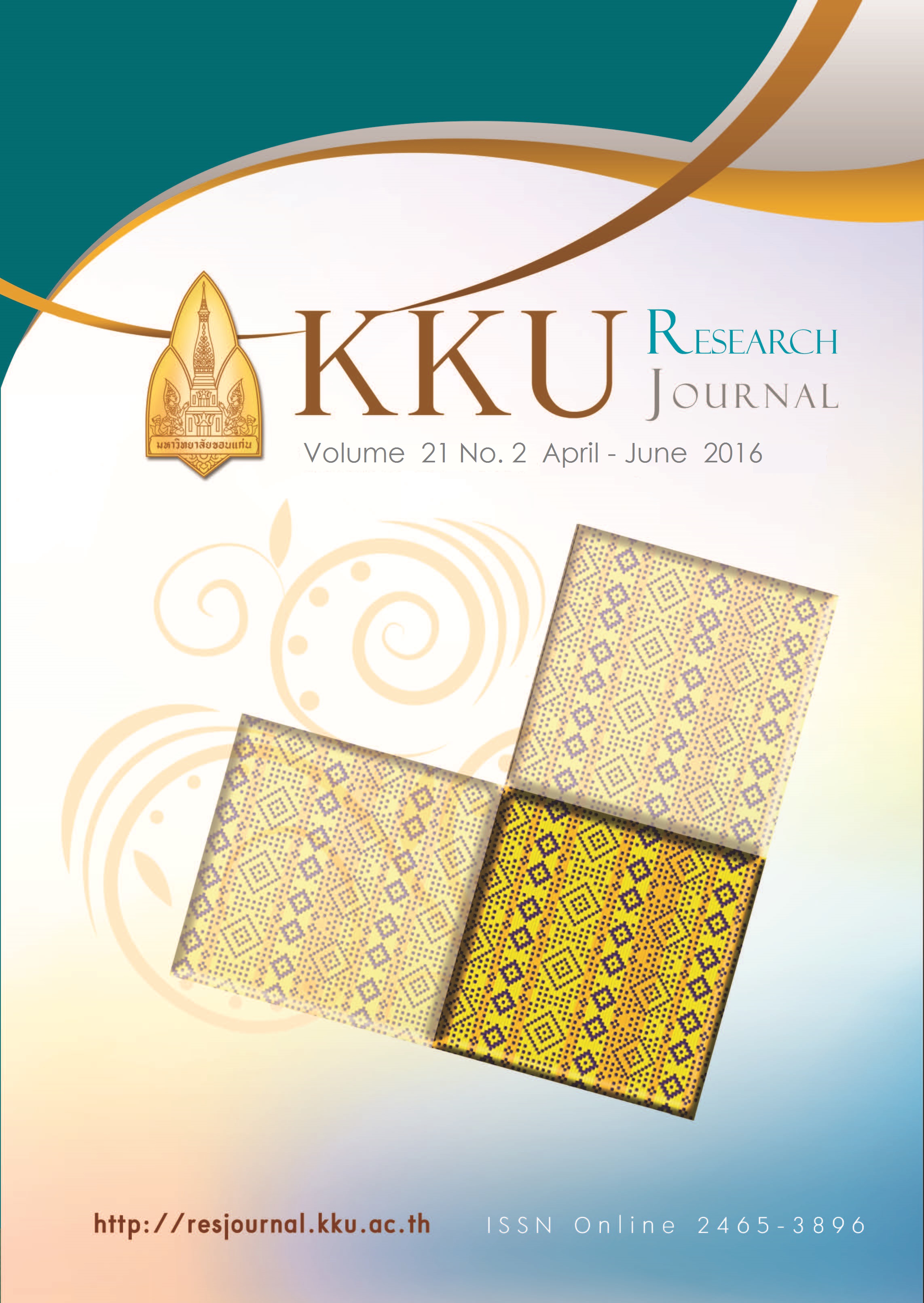Screening of oleaginous yeast for lipid production using rice residue from food waste as a carbon source
Main Article Content
Abstract
Rice residue from food waste contained of starch as a mainly component which could be either hydrolyzed to be fermentable sugars or directly used as a carbon source for the growth and high value metabolites production by various microorganisms. Therefore, this study focused on the utilization of rice residue and rice residue hydrolysate from food waste as a carbon source for the growth and lipids production of oleaginous yeast. Rice residue obtained from canteen of the Faculty of Agro-Industry, Chiang Mai University, Thailand. It composed of moisture content (76.68±0.55%), crude fat (1.76±0.47%), crude protein (3.04±0.06%), ash content (0.46±0.07%), and carbohydrate content (18.05±0.01%), respectively. Rice residue was then subjected to enzymatic hydrolysis using α-amylase and amyloglucosidase (AMG), resulting the maximal reducing sugars of 168.02±0.02 g/L. The
screening of oleaginous yeast from flowers and leaves samples from Doi-Inthanon National Park, Faculty of Agro-Industry, Chiang Mai University, the culture collection of the Thailand Institute of Scientific and Technological Research (TISTR) and the Division of Biotechnology, Faculty of Agro-Industry, Chiang Mai University were investigated. Sixty-seven isolates were obtained, and only four isolates were identified as oleaginous yeast because of containing high lipids content more than 20% (w/w), when glucose or rice residue hydrolysate was used as a carbon source. Those oleaginous yeasts were identified as Rhodotorula sp. C7, Rhodosporidium paludigenum C10, and the new isolate TC32, respectively. Their growths and lipid productions were compared with Diozegia sp. TISTR5792. The results showed that, C7, C10, TISTR5792 and TC32 produced the maximal lipids content of 24.26±0.56, 23.69±0.91, 22.43±1.09 and 23.07±0.80% (w/w) when cultivated in the basal medium supplemented with enzymatic-rice residue hydrolysate. Surprisingly, we found that TISTR5792 and TC32 could grow well in the medium supplemented with rice residue "> (without hydrolysis) and showed lipids content of 18.41±0.10 and 21.67±0.02% (w/w), respectively. These results indicated that rice residue from food waste shows a high potential to be an effective carbon source for the growth and lipid production of the selected oleaginous yeasts.
Article Details
References
[2] Kongjan P, Min B, Angelidaki I. Biohydrogen production from xylose at extreme thermophilic temperatures (70◦C) by mixed culture fermentation. Water Res 2009; 43:1414–24.
[3] Shin HS, Youn JH, Kim SH. Hydrogen production from food waste in anaerobic mesophilic and thermophilic acidogenesis. Int J Hydrogen Energy 2004; 29:1355–63.
[4] Reungsang A, Sreela-or C. Bio- Hydrogen Production from Pineapple Waste Extract by Anaerobic Mixed Cultures. Energies 2013; 6: 2175–90.
[5] Pattra S, Sangyoka S, Boonmee M, Reungsang A. Bio-hydrogen production from the fermentation of sugarcane bagasse hydrolysate by Clostridium butyricum. Int J Hydrogen Energy 2008; 33: 5256–65.
[6] Sittijunda S, Reungsang A. Media optimization for biohydrogen production from waste glycerol by anaerobic thermophilic mixed cultures. Int J Hydrogen Energy 2012; 37: 15473–82.
[7] Su HB, Cheng J, Zhou JH, Song WL, Cen KF, Improving hydrogen production from cassava starch by combination of dark and photo fermentation. Int J Hydrogen Energy 2009; 34: 1780–6.
[8] Intano P, Rangsanvigit, Malakul P, Chavadej S. Optimization of separate hydrogen and methane production from cassava wastewater using two-stage upflow anaerobic sludge blanket reactor (UASB) system under thermophilic operation. Bioresour Technol 2014; 173: 256–65.
[9] Lee KS, Hsu YF, Lo YC, Lin PJ, Lin CY, Chang JS. Exploring optimal environmental factors for fermentative hydrogen production from starch using mixed anaerobic microflora. Int J Hydrogen Energy 2008; 33: 1565–72.
[10] Arimi MM, Knodel J, Kiprop A, Namango SS, Zhang Y, Geisen SU. Strategies for improvement of biohydrogen production from organic-rich wastewater: A review. Biomass & Bioenerg 2015; 75: 101 –18.
[11] Wang J, Wan W. Factors influencing fermentative hydrogen production: a review. Int J Hydrogen Energy 2009; 34: 799–811.
[12] Ren NQ, Guo WQ, Wang XJ, Xiang WS, Liu BF, Wang XZ, Ding J, Chen ZB. Effects of different pretreatment methods on fermentation types and dominant bacteria for hydrogen production. Int J Hydrogen Energy 2008; 33: 4318–24.
[13] Ginkel SV, Sung S. Biohydrogen production as a function of pH and substrate concentration. Environ Sci Technol 2001; 35: 4726–30.
[14] Mohan SV, Babu VL, Sarma PN. Effect of various pretreatment methods on anaerobic mixed microflora to enhance biohydrogen production utilizing dairy wastewater as substrate. Bioresour Technol 2008; 99: 59–67.
[15] Chen CC, Lin CY, Lin MC. Acid base enrichment enhances anaerobic hydrogen production process. Appl Microbiol Biotechnol 2002; 58: 224–8.
[16] O-Thong S, Prasertsan P, Birkeland NK. Evaluation of methods for preparing hydrogen-producing seed inocula under thermophilic condition by process performance and microbial community analysis. Bioresour Technol 2009; 100: 909–18.
[17] Lee MJ, Song JH, Hwang SJ. Effects of acid pre-treatment on bio-hydrogen production and microbial communities during dark fermentation. Bioresour Technol 2009; 100: 1491–3.
[18] Cai ML, Liu JX, Wei YS. Enhanced biohydrogen production from sewage sludge with alkaline pretreatment. Environ Sci Technol 2004; 38: 31951–202.
[19] Lin CY, Lay CH. A nutrient formulation for fermentative hydrogen production using anaerobic sewage sludge microflora. Int J Hydrogen Energy 2005; 30: 285–92.
[20] Owen WF, Stuckey DC, Healy Jr JB, Young LY, McCarty PL. Bioassay for monitoring biochemical methane potential and anaerobic toxicity. Water Res 1979; 13: 485–93.
[21] APHA–AWWA–WPCF.1992. Standard method for examination of water and wastewater. 18th Ed, Washington, DC.
[22] Nielsen SS. 2010. Phenol-sulfuric acid method for total carbohydrates. Food analysis laboratory manual: Food Science Texts Series. Springer, US.

